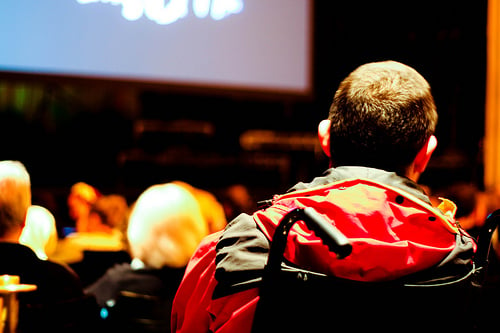
Individual in a wheelchair watches arts event
Photo: MMcQuade via Creative Commons ccby-nd2.0
Arts organisations fall down on the marketing of accessible events
Improvements in physical access for disabled people have not been matched by better strategies to attract audiences, says new report.
Although arts organisations are improving their provision of physical access for disabled audiences, access schemes and accessible events need to be communicated more effectively, according to a new report.
‘Understanding Disabled People as Audiences 2012-13’, published by Shape Arts, is based on an analysis of the behaviour of disabled people who engaged with Shape’s own Audience Services activities during the year. The disability-led organisation deals with enquiries from disability groups and individuals needing assistance to attend cultural events and venues, and has issued the report with the aim of widening understanding of disabled people as audiences, the barriers they face and how they access the arts sector.
A key problem in the sector is consistency and the report calls for best practice, experiences and ideas to be shared.
Organisations’ access schemes were found to vary in the levels of support they offer for disabled people as audiences. This includes variation in application processes; request for proof of disability; concessionary rates policies; and support provided when a disabled person attends an event.
The report suggests that organisations are “failing to effectively promote their accessible events and access schemes through their marketing and communication strategies”, and says they should be “actively marketing” to encourage attendance.
According to Shape trainer Nick Goss, better customer service involves both physical access and effective promotions, as “disabled people often emphasise that the more they know, the better choices they can make”. He confirmed: “Venues often underestimate their accessibility to disabled people by focussing only on the physical access barriers, rather than thinking more about the very real opportunities they all have to attract more diverse audiences by being inclusive to all. There is a need to combine enhanced physical access with effective marketing strategies, practices and procedures.”
57% of respondents indicated that transport was a barrier to arts attendance, but 52% noted a financial barrier, indicating that ticket pricing concessions might also need to be addressed.
The need for some individuals to have one-to-one assistance, which is not always available, is sometimes a problem too, and Shape recommends engaging and retaining dedicated volunteers to support disabled people, as well as providing relevant training for those in Front of House roles.
Developing Access Groups at cultural venues is also suggested as a means of identifying and breaking down barriers.
Join the Discussion
You must be logged in to post a comment.